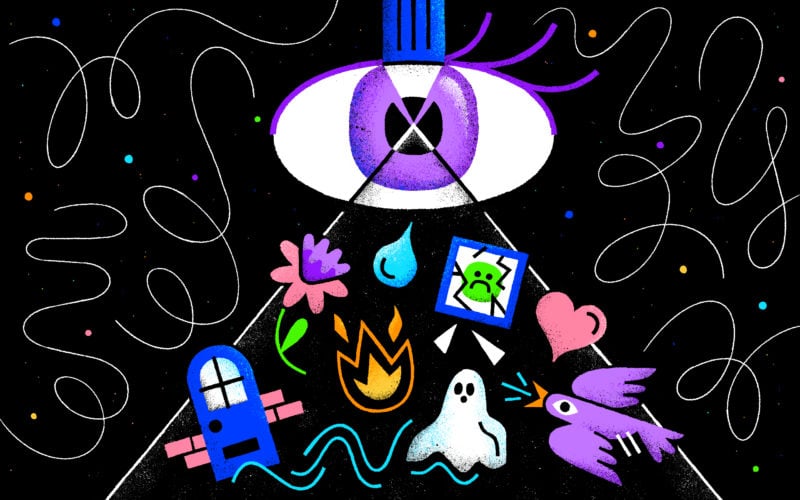Illustration: Laura Bee
Have you ever tried writing your own lyrics?
I like to think that music fans fall into one of two camps: those who listen to songs without paying much attention to the lyrics, and those for whom lyrics can make or break a song. I personally fit in with the latter – I think songwriting is an art, and one that takes skill, dedication, practice, and constant improvement.
Established songwriters make it look easy, but if you’ve ever tried to write your own song, you’ll know that great lyrics don’t just pour out of you (not at first, anyway). There needs to be thought, intention, cohesiveness, and a certain level of skill behind them.
In this article, let’s go over a few of my favorite tips for writing better lyrics. Keep these in mind as you write, and you’ll quickly go from writing cheesy and repetitive lyrics to lyrics that evoke emotion and help your audience better understand and relate to your music.
Let’s dive in!
1. Show, don’t tell
Songwriting is a form of storytelling, and as with any story, it can be tempting to simply describe to your audience what happened and how you felt about it.
Imagine you’re telling a story about a relationship that has ended, and you’d like to convey how much you miss that person. You can, of course, just write lyrics like “I loved you and now you’re gone” or “I miss you with all my heart.” But, what if instead of telling us how you feel, you showed us?
Think of a person who clearly misses a former love. How do they act? How do they spend their time? Give us a glimpse of their day-to-day life and their thoughts. This will lead to a story that’s much more realistic and, therefore, relatable.
To help you do this, try treating your songwriting like a game of Taboo. Talk about love without ever including the word “love” in your song. Talk about missing someone without including the word “miss.”
As an example, in Bruno Major’s “Just the Same,” instead of saying “Get angry with me,” he says, “Smash all the pictures where I am in the frame.” Both convey the same emotion, but the latter is much more powerful and memorable.
2. Make use of imagery
A big reason why the idea of “show, don’t tell” works so well is because it gives us an opportunity to use our imagination and picture a scene in our minds. Being able to imagine the lyrics of a song engages more than just our listening skills – it creates an immersive experience, allowing us to feel the song more deeply, remember it better, and associate our own emotions with it.
When you have the chance, try to embellish your song with something the listener can visualize – this can be the room that the main character is in, the clothes they’re wearing, or an action they’re in the middle of. It doesn’t even have to be realistic; in fact, our minds are so powerful, they can imagine things that don’t exist in real life. Sometimes, creating a scene that one would normally never see in reality is the best way to convey a message in a unique and memorable way.
Take the second verse of JP Cooper’s “All This Love,” for example. He sings about an old relationship and how that person’s things are still all over his house, making it hard for him to move on. Of course, instead of putting it so simply, he says:
Water’s getting rough, swimming in your stuff, I just wanna get to the shore
I’m drowning in memories of you that I try to ignore
Still, I’m playing host hanging with the ghosts, telling them the story of you
They always laugh at my jokes as we dance through the room
I don’t know about you, but I can’t help but picture JP Cooper literally swimming in an ocean of clothes and then having a dance party with a few friendly ghosts. It’s whimsical, but it works – I can imagine myself there, remember what it’s like to miss someone, and relate to what he’s feeling.
3. Don’t overuse metaphors
Another great technique in songwriting, and one you’re probably very familiar with, is using metaphors. However, there’s a difference between a cheesy metaphor that was thrown in for the sake of having a metaphor, and one that’s more subtle and intentional.
When it comes to metaphors, the key is to not overdo it. They’re a great tool for comparing one thing to another in order to explain its meaning or highlight its significance, but it’s too easy to rely on metaphors to make a song seem interesting.
If you’re going to use metaphors, stick to just a few, and make sure they fit the same theme or relate to each other somehow. When you use too many unrelated metaphors, the song can quickly become too confusing to decipher and your intended meaning can get lost.
The best way to avoid overusing metaphors is to make sure that you’re also doing the opposite – balance them with lines that are simple, to-the-point, and, again, show an emotion rather than describe it with fancy words and comparisons.
Here’s an example from Luca Fogale’s “I Don’t Want To Lose You.” First, he subtly compares his love interest to a bird:
And there’s a darkness in the way you sing
And something curious in how you walk, as if you got a broken wing
That makes me wanna help you find a way to throw your shadow
We can even sing songs about your past loves at my piano
Note the last line here – there are no metaphors; it’s just an invitation for them to sing together. But underneath the simplicity, he’s saying, “share your pain with me – I won’t judge or get jealous; your wellbeing is my priority.” No metaphor can achieve the depth that a simple, literal line does here.
4. Avoid lyrics that are clichés
One of the worst things you can do for your song is fill it with overused lyrics. How many times have you heard the phrases “set me free,” “my broken heart,” “hold me close,” or “never let you go?” These (and many others) are used so often in songs that they’re considered too easy, and are usually a sign of poor songwriting.
You may ask, “Then why do we hear them so often on the radio?” Well, the artists we hear on the radio already have a reputation, a signature sound, and an established fanbase – they don’t need to impress anyone with their writing skills. However, if you’re less known or just breaking into the music industry, it’s absolutely crucial that your songs are unique and creative, and have the ability to stand out among the noise.
Here’s a good rule of thumb to follow to help you avoid using cliché phrases: if it sounds familiar, don’t use it. Of course, there are always exceptions; one or two of these phrases is usually okay, especially if you surround them with creative details or put your own spin on them. But whatever you do, don’t stuff your song with cliché lyrics in every line.
If you find yourself gravitating towards easy, familiar lyrics, challenge yourself to come up with a way to say the same thing using different words. Revisit the first two tips and use imagery to show the listener what you’re trying to convey, instead of just telling them.
5. Find new ways to say the same thing
Finding different ways to say the same thing doesn’t just come in handy when you’re trying to save your song from having too many clichés. It’s also just a great technique to use whenever you want your lyrics to be more interesting or captivating.
Saying something in a way that people don’t normally hear in everyday conversation grabs the listener’s attention and helps them relate to your song in a unique way. When done correctly, it can make the listener think, “No one has ever put it this way before, but this is exactly how I feel.” Lines like this are what help the listener form a unique bond with your song, and can even lead to them becoming a lifelong fan.
One of my favorite songwriters is Kevin Garrett. He does this quite a lot in his songwriting, but here’s a quick example from his song “Never Knock:”
You are in my head
When my heart’s a war
And if I’m ever scared
I’ll breathe the air in front of your door
He could have said, “I’ll stand in front of your door,” but the way he put it is so much more vulnerable and packs so much more emotion. It’s easily one of my favorite lyrics of all time.
6. Try new rhyming schemes
Common rhyming schemes in songwriting are ABAB or AABB, but there are so many more options out there. If you’re feeling uninspired, look to poetry to see what rhyming schemes are used and what effect they help achieve.
You can even create your own rhyming scheme by altering or combining the schemes you already know. Take AABB and turn it into ABCC, for example. The first two lines don’t even have to rhyme, as long as the last two do. Or take the ABCC structure and repeat it in the next stanza (a group of four lines) to create ABCC ABCC. Here, the first line of the first stanza rhymes with the first line of the second stanza, and so on. Not everyone might notice this, but those who do will absolutely give a nod to your creativity. There are really no rules to rhyming schemes, and the more you deviate from what’s expected, the more interesting your song will be.
Another thing you can try is playing around with the placement of your rhymes. Most rhymes are placed at the ends of lines for maximum effect, but there’s nothing that says rhymes can’t exist anywhere else. You can create internal rhymes, where words rhyme in the middle of the line. You can place two or three rhyming words next to each other.
Here’s a classic example of an internal rhyme from The Beatles:
Hey Jude, don’t be afraid.
You were made to go out and get her.
The minute you let her under your skin,
Then you begin to make it better.
You can even make two lines end with the same word, and make the second-to-last words rhyme instead.
7. Don’t force rhymes
While we’re on the subject of rhymes, one of the biggest signs of poor songwriting is forced rhymes. This happens when you set your heart on a perfect rhyme and come up with the rest of the line to help make that rhyme make sense. What you end up with is a cheesy, overused rhyme like “make up” and “break up,” and lyrics that were thrown together with no intention.
To overcome the tendency to force rhymes, let go of the idea that rhymes have to be perfect. Sure, this may be a must in certain genres of poetry, but in songwriting, there’s so much more to a song than perfect rhymes.
Rather than focusing on coming up with the best word to place at the end of your line, focus more on following the previous six tips – they’ll carry most of the weight in making your song more interesting and more meaningful.
If you can find a perfect rhyme and still say exactly what you wanted to say, great – but don’t spend too much time on it. You can always get away with a relatively loose rhyme because more often than not, the melody and the rhythm of the song will help trick the listener’s mind into hearing it as a perfect rhyme anyway.
If you can’t find even a loose rhyme, let go of the idea that lines have to rhyme at all! There are plenty of great songs that don’t have a single rhyme.
Take a look at Beyoncé’s “Pray You Catch Me” (another shoutout to Kevin Garrett for writing this one):
You can taste the dishonesty, it’s all over your breath
As you pass it off so cavalier
But even that’s a test
Constantly aware of it all
My lonely ear
Pressed against the walls of your world
It can be hard to notice at first, but this verse has an ABACBC rhyming scheme, where the rhyming words are “breath / test,” “cavalier / ear,” “all / world.” These words barely rhyme, but the lyrics, melody, arrangement, and performance more than make up for it, coming together to create an achingly beautiful piece of music.
8. Prioritize your message
Whether it’s with rhymes, structure, the number of syllables in a line, or rhythm, it’s common to create rules for yourself and try to force your songwriting to fit those rules. We come up with a first verse, and then lose our minds trying to write a second verse that matches.
My personal philosophy when it comes to songwriting is to always prioritize the message. I like to sit down and write in prose what my story is going to be about, or write a few lines I know I definitely want to include. Then, I build the song around those lines, and use all of the above techniques to turn the prose into lyrics.
If things don’t quite rhyme, or if I can’t maintain the same structure or rhythm, I don’t stress over it. I let the story lead the way and trust that the message is more important than anything else.
That’s all the tips I have for now! Of course, there are other things you can do to improve your songwriting – habits, exercises, and prompts you can try. If you struggle with writing lyrics and would be interested in learning more, let us know in the comments below!
Explore royalty-free sounds from leading artists, producers, and sound designers:
March 12, 2021



